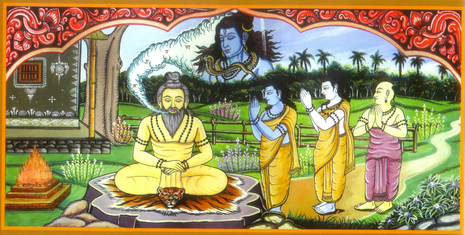Vyakarana Vedanga (व्याकरणवेदाङ्गम्)
| This article needs editing.
Add and improvise the content from reliable sources. |
Vyakarana (Samskrit: व्याकरणम्) roughly translated as grammar, one of the important topics in the shad vedangas, is the foundation of language and communication in the evolutionary history of human beings. In the tradition of vyakarana, one can see the origin of analysis tracing back to Vedas. There are innumerable references to language elements, structure and nature in classical literature. Evidence shows that the terminology used for language analysis has its origin in the Vedas.[1]
Introduction
The philosophy of language evolved by the schools of Vyakarana and Mimasa, is the outcome of elaboration of the suggestions found in the Vedas. The divine nature of speech, the creative and illuminative power of the word and the different levels of speech are the main doctrines which formed the philosophy of language in Bharatiya shastras. Of the six vedangas, the ancillary disciplines of the Vedas, Siksha (pronunciation), Vyakarana (grammar) and Nirukta are directly connected with the Vedas.
Every system of thought and the various darshana schools had to consider language at some stage or other and each one had given attention to the ultimate question concerning the relation between the word and reality. Language had both outer empirical and inner metaphysical dimensions. Panini and Patanjali while elaborating on technical and grammatical aspects of human speech also discussed the divine nature of Vak (वाक्) and the metaphysical qualities of language. Shabda has been directly identified with the language of Vedas as Shabda Brahman and the divine Vak has been considered as the seed of creation. Bharatiya Vyakarana shastra brings one to a unique inquiry of the seers who advocated that shabdas which fall within the limits of vyakarana rules only should be employed for that would fetch dharma to the individual. Thus use and abuse of language came into the precincts of vyakarana.[1]
While it is possible to transform the meaning from the speaker to the listener through both śabdas and apaśabdas. Vyākaraṇam prescribes that one should employ śabdas only. Here the term śabdas refers to sādhuśabdas (perfect śabdas that are acceptable to vyākaraṇa).
Origin and History of Vyakarana
Brahma was the first author of vyakarana, who transmitted this science to Brhaspati, who transmitted it to Indra, who in turn gave it to Bharadvaja. The rshis learnt it from Bharadvaja and from them it reached Brahmanas.[1]
It is indisputable that language and literature of Bharatavarsha began with the Vedas. Five rk mantras have been chosen and discussed in relation to vyakarana, by Patanjali in the Paspashnika of his Mahabhashya.
चत्वारि वाक्परिमिता पदानि तानि विदुर्ब्राह्मणा ये मनीषिणः । गुहा त्रीणि निहिता नेङ्गयन्ति तुरीयं वाचो मनुष्या वदन्ति ॥४५॥ (Rig. Veda. 1.164.45)
चत्वारि शृङ्गा त्रयो अस्य पादा द्वे शीर्षे सप्त हस्तासो अस्य । त्रिधा बद्धो वृषभो रोरवीति महो देवो मर्त्याँ आ विवेश ॥३॥ (Rig. Veda. 4.58.3)
सुदेवो असि वरुण यस्य ते सप्त सिन्धवः । अनुक्षरन्ति काकुदं सूर्म्यं सुषिरामिव ॥१२॥ (Rig. Veda. 8.69.12)
सक्तुमिव तितउना पुनन्तो यत्र धीरा मनसा वाचमक्रत । अत्रा सखायः सख्यानि जानते भद्रैषां लक्ष्मीर्निहिताधि वाचि ॥२॥ (Rig. Veda. 10.71.2)
Gopathabrahmana of Atharvaveda mentions many terms that we use in vyakarana even today.
ओंकारं पृच्छामः। को धातुः। किं प्रातिपदिकम्। किं नामाख्यातम्। किं लिङ्गम्। किं वचनम्। का विभक्तिः। कः प्रत्ययः। कः स्वर उपसर्गो निपातः। किं वै व्याकरणम्। को विकारः। को विकारी। कतिमात्रः। कतिवर्णः। कत्यक्षरः। कतिपदः। कः संयोगः। किं स्थानानुप्रदानकरणं। (Gopa. Brah. 1.1.24)[2]
Meaning: Let us analyse Omkara, what is the dhatu? what is pratipadika? what is nama and akhyata? what is lingam ? what is vibhakti ? what is pratyaya? what is svara, upasarga, nipata? what is vyakarana? what is vikara? what is vikari and how many matras? how many varnas? how many aksharas? how many pada-s? what is samyoga? what is staana-naada-anupradana and anukaranam?
Apart from Gopatha Brahmana, Maitrayana samhita and Aitareya Brahmana also discusses different vibhaktis.
References
- ↑ 1.0 1.1 1.2 Subramanya Sharma. V. M. (2012) Ph.D Thesis: The Notion of Word in Vakyapadiyam. Hyderabad : University of Hyderabad
- ↑ Gopatha Brahmana (Purvabhaga)

